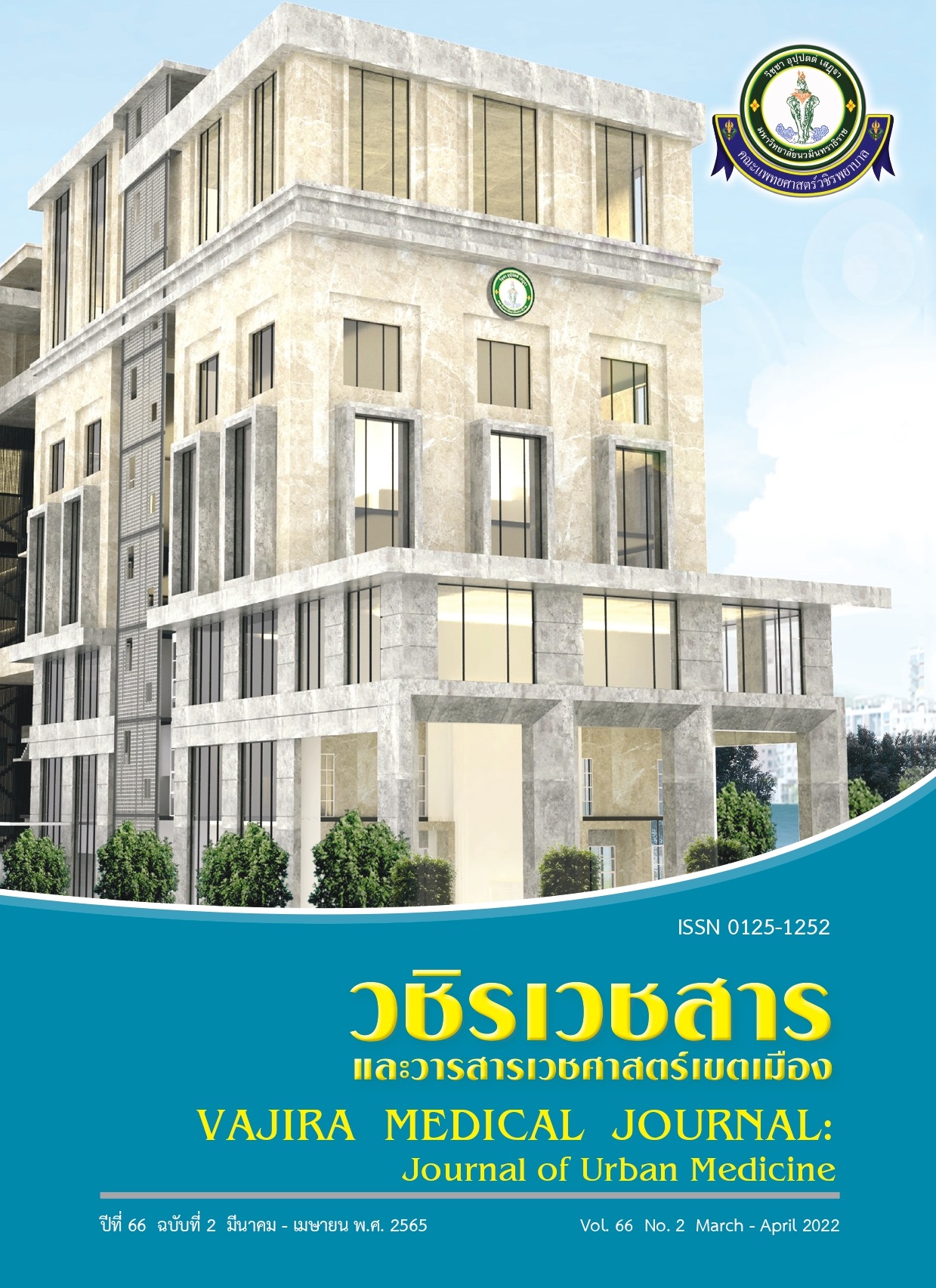Outcome of Self-Efficacy Enhancement Program on Knowledge and Confidence of Foot Ulcers Prevention Behavior in the Diabetic Elderly of the Puranawat Temple Elderly Club, Bangkok
Main Article Content
Abstract
Objectives: To study and compare knowledge of foot ulcer prevention before and after program implementation and to compare foot ulcers prevention behavior before program implementation and confidence of foot ulcers prevention behavior after program implementation in the diabetic elderly of the Puranawat Temple Elderly Club, Bangkok.
Method: The research was quasi experimental research with one group pre-post-test design. The purposively selected samples were thirty Diabetic elderly of the Puranawat Temple Elderly Club, Bangkok. The research tool was the modified program of the Self-Efficacy Theory of Bandura. Data were collected from questionnaire for the period of 3 days. Data were analyzed by percentage, mean, standard deviation and paired t-test.
Results: Before and after program implementation, the diabetic elderly had good and very good level of knowledge about foot ulcers prevention respectively. After program implementation, the knowledge about foot ulcer prevention of the samples were statistical significantly higher than before the program (p < 0.01). Results of the compare the foot ulcers prevention behavior before program implementation. The samples had average level of behavior before program implementation. After program implementation, they had high level of confidence which was higher than the level of behavior before program implementation with statistical significance (p < 0.01) in overall and in each aspect. The aspect with the highest confidence was foot examination and the aspect with the least confidence was foot cleaning.
Conclusion: The Self-Efficacy Enhancement Program on knowledge and confidence of foot ulcers prevention behavior in the diabetic elderly of the Puranawat Temple Elderly Club showed significant improvement of knowledge and confidence in the diabetic elderly. The program was designed for health teams, village health volunteers and other interested groups to enhance foot care self-efficacy and help the diabetic elderly in communities to prevent foot ulcers and leg amputation.
Downloads
Article Details

This work is licensed under a Creative Commons Attribution-NonCommercial-NoDerivatives 4.0 International License.
References
International Diabetes Federation. Diabetes situation in 2017 [Internet]. Hfocus; 2018 [cited 2020 June 20]. Available from: https://www.hfocus.org/content/2019/11/18054 (in Thai).
AekplakornI W, Nitiyanant W, Sornpaisarn B, Khananuraksa P. Health System Research Institute (HSRI). Thai National Health Examination Survey, NHES V. Bangkok: Aksorn Graphic and Design; 2016.
Department of Disease Control. Noncommunicable disease information, number and Death rate of diabetes, 2018 [internet]. Department of Disease Control; 2019 [cited 2020 April 12]. Available from: www.thaincd.com/2016/mission/documents-detail.php?id=13653&tid=32&gid=1-020 (in Thai).
Institute of Medical Research and Technology Assessment. Clinical Practice Guideline: Prevention and Management of Diabetic Foot Complications. Bangkok: Institute of Medical Research and Technology Assessment; 2013.
Office of Public Health System Development. Issues on World Diabetes Day Campaign 2016 [Internet]. Division of Non-Communicable Disease, Department of Disease Control. Ministry of Public Health; 2017 [cited 2020 January 13]. Available from: http://www.thaincd.com/2016/news/hot-news- detail.php?id=12305&gid=18 (in Thai).
Nakkling Y, Tudsri P. Effect of Self–Efficacy Enhancement program on health Behaviors among Older Adults with Uncontrolled hypertension. APHEIT Journal 2017;6:27-35. (in Thai).
Buasom P, Promsiripaiboon Y, Sonkasetrin A. Effects of self-efficacy program on health the behavior modification in elderly of high blood pressure risk group in Rommanee Sub-district, Kapong district Phangnga province. Community Health Development Quarterly Khon Kaen University 2017;5(4):551-67. (in Thai).
Udomkaeo N, Meethiang P, Krongyuth P, Bunsiriluck S. Assessment of the application health efficacy program in diabetes type II patients for their caregivers, Warinchamrap district, Ubon Ratchathani province. In: Prathepha P. the 13th Mahasarakham research university academic conference, from local to global in the context of Thailand 4.0; 2017 Sap 7-8; Mahasarakham University. Faculty of humanities and social sciences Mahasarakham: Mahasarakham University; 2017. p. 433-43. (in Thai)
Wangpitipanit S, Terathongkum S, Pakpayak M. Effects of a RANS 30 Exercise Program on Diabetic Preventive Behavior, Body Mass Index, and Capillary Blood Glucose in Persons with Pre-diabetes. Rama Nurs J 2017; 23(3): 358-70. (in Thai).
Bandura, A. Self-efficacy:The exercise of control. New York: W.H. Freeman; 1997.
Janpech P, Puncha-Glingasorn A, Srinoi W. Effects of Foot Care Behaviors Promoting Program among Diabetic Patients in Phra That Sub-district, Chiang Khwan District, Roi Et Province. Nursing 2019; 13(3):94-105.
Iamsomboon T, Kengganpanich T, Kengganpanich K, Benjakul S. Effect of Promoting Program for Foot Self-Care Behaviors and Foot Ulcers Among Diabetic Patients, Krathumbaen Hospital, Samut Sakhon Province. Journal of Public Health 2017; 47: 289-300. (in Thai).
Phanphuech P. Effects of the self-efficacy and social support enhancement program on foot care behavior among the elderly with diabetes mellitus. [Thesis]. Chonburi: Burapha University;2013.
Faul F, Erdfelder E, Lang AG, Buchner A. G*Power 3: a flexible statistical power analysis program for the social, behavioral, and biomedical sciences. Behav Res Methods 2007; 39(2): 175-191.
Department of medical sciences. Knowledge about diabetes. Ministry of Public Health. Pathum Thani Province: Miraculous; 2012. (in Thai).
MEGA FUN. Infographic Diabetes [Video]. 2018 [cited 2020 January 13]. Available from: https://www.youtube.com/watch?v=JFjPZkkSztA (in Thai).
Praram 9 Hospital. Foot care for diabetics by the Diabetes and Metabolic Center Praram 9 Hospital [Video]. 2017[Cited 2020 January 13]. Available from: https://www.youtube.com/watch?v=q8uzrUUJGbg (in Thai).
WMC Hospital. How to treat diabetic foot? – Dr.Boripat Wongprachum [Video]. 2018 [Cited 2020 January 13]. Available from: https://www.youtube.com/watch?v=Aj4_ksQpmYI.
Chusak T, Sasang N, Chaleoykitti S. Effect of diabetes foot care program to prevent leg cramps of type 2 diabetic patients, Samrongchai sub-district,Phisalee district, Nakhon Sawan province. Royal Thai Army Medical Journal 2018;71(2), 105-112. (in Thai).
Sasee T, Muktabhant B, Uttamavatin P. Factors Associated with Foot Care Behavior of Type 2 Diabetic Patients Living in Kham Bo Subdistrict, Waritchaphum District, Sakon Nakhon Province. Journal of Sakon Nakhon Hospital 2018; 21:87-98. (in Thai).
Prachanno W, Ratree A, Gadudom P. Effects of a Self-Foot Care Program for People with Diabetes in Klonglekbon Community Thamai District, Chanthaburi Province. J Prapokkklao Hosp Clin Med Educat Center 2015; 32: 126-34.(in Thai).
Srimaksook K. The Outcomes of the Utilization of Clinical Nursing Practice Guidelines in Prevention of Foot Ulcer Amongst Diabetic Type II Patients. [Thesis]. Nakhon Pathom: Christian University of Thailand; 2014.


